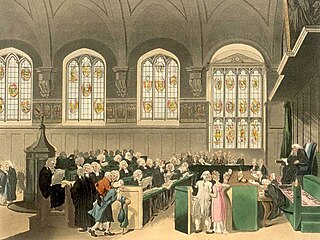
The Employee Retirement Income Security Act of 1974 (ERISA) is a U.S. federal tax and labor law that establishes minimum standards for pension plans in private industry. It contains rules on the federal income tax effects of transactions associated with employee benefit plans. ERISA was enacted to protect the interests of employee benefit plan participants and their beneficiaries by:
Restitution and unjust enrichment is the field of law relating to gains-based recovery. In contrast with damages, restitution is a claim or remedy requiring a defendant to give up benefits wrongfully obtained. Liability for restitution is primarily governed by the "principle of unjust enrichment": A person who has been unjustly enriched at the expense of another is required to make restitution.

A fiduciary is a person who holds a legal or ethical relationship of trust with one or more other parties. Typically, a fiduciary prudently takes care of money or other assets for another person. One party, for example, a corporate trust company or the trust department of a bank, acts in a fiduciary capacity to another party, who, for example, has entrusted funds to the fiduciary for safekeeping or investment. Likewise, financial advisers, financial planners, and asset managers, including managers of pension plans, endowments, and other tax-exempt assets, are considered fiduciaries under applicable statutes and laws. In a fiduciary relationship, one person, in a position of vulnerability, justifiably vests confidence, good faith, reliance, and trust in another whose aid, advice, or protection is sought in some matter. In such a relation, good conscience requires the fiduciary to act at all times for the sole benefit and interest of the one who trusts.
A fiduciary is someone who has undertaken to act for and on behalf of another in a particular matter in circumstances which give rise to a relationship of trust and confidence.

Subrogation is the assumption by a third party of another party's legal right to collect debts or damages. It is a legal doctrine whereby one person is entitled to enforce the subsisting or revived rights of another for one's own benefit. A right of subrogation typically arises by operation of law, but can also arise by statute or by agreement. Subrogation is an equitable remedy, having first developed in the English Court of Chancery. It is a familiar feature of common law systems. Analogous doctrines exist in civil law jurisdictions.
A legal remedy, also referred to as judicial relief or a judicial remedy, is the means with which a court of law, usually in the exercise of civil law jurisdiction, enforces a right, imposes a penalty, or makes another court order to impose its will in order to compensate for the harm of a wrongful act inflicted upon an individual.

In trust law, a constructive trust is an equitable remedy imposed by a court to benefit a party that has been wrongfully deprived of its rights due to either a person obtaining or holding a legal property right which they should not possess due to unjust enrichment or interference, or due to a breach of fiduciary duty, which is intercausative with unjust enrichment and/or property interference. It is a type of implied trust.
Chauffeurs, Teamsters, and Helpers Local No. 391 v. Terry, 494 U.S. 558 (1990), was a case in which the United States Supreme Court held that an action by an employee for a breach of a labor union's duty of fair representation entitled him to a jury trial under the Seventh Amendment.
Sereboff v. Mid Atlantic Medical Services, Inc., 547 U.S. 356 (2006), was a case decided by the Supreme Court of the United States involving the ability of an Employee Retirement Income Security Act (ERISA) plan fiduciary to recover medical costs from a beneficiary who has been reimbursed for injuries by a third party. The Court ruled unanimously that ERISA permitted the fiduciary to recover costs from the settlement proceeds a beneficiary received in a personal injury lawsuit.
Mertens v. Hewitt Associates, 508 U.S. 248 (1993), is the second in the trilogy of United States Supreme Court ERISA preemption cases that effectively denies any remedy for employees who are harmed by medical malpractice or other bad acts of their health plan if they receive their health care from their employer.
Self-funded health care, also known as Administrative Services Only (ASO), is a self insurance arrangement in the United States whereby an employer provides health or disability benefits to employees using the company's own funds. This is different from fully insured plans where the employer contracts an insurance company to cover the employees and dependents.
Australian trust law is the law of trusts as it is applied in Australia. It is derived from, and largely continues to follow English trust law, as modified by state and federal legislation. A number of unique features of Australian trust law arise from interactions with the Australian systems of company law, family law and taxation.
Aetna Health Inc. v. Davila, 542 U.S. 200 (2004), was a United States Supreme Court case in which the Court limited the scope of the Texas Healthcare Liability Act (THCLA). The effective result of this decision was that the THCLA, which held Case Management and Utilization Review decisions by Managed Care entities like CIGNA and Aetna to a legal duty of care according to the laws of The State of Texas could not be enforced in the case of Health Benefit plans provided through private employers, because the Texas statute allowed compensatory or punitive damages to redress losses or deter future transgressions, which were not available under ERISA § 1132. The ruling still allows the State of Texas to enforce the THCLA in the case of Government-sponsored (Medicare, Medicaid, Federal, State, Municipal Employee, etc., Church-sponsored, or Individual Health Plan Policies, which are saved from preemption by ERISA. The history that allows these Private and Self-Pay Insurance to be saved dates to the "Interstate Commerce" power that was given the federal Government by the Supreme Court. ERISA, enacted in 1974, relied on the "Interstate Commerce" rule to allow federal jurisdiction over private employers, based on the need of private employers to follow a single set of paperwork and rules for pensions and other employee benefit plans where employers had employees in multiple states. Except for private employer plans, insurance can be regulated by the individual states, and Managed Care entities making medical decisions can be held accountable for those decisions if negligence is involved, as allowed by the Texas Healthcare Liability Act.
In the United States, ERISA reimbursement refers to the efforts of an ERISA Plan administrator to obtain repayment from an insured person who had previously received payments for personal injury medical bills.

FHR European Ventures LLP v Cedar Capital Partners LLC[2014] UKSC 45 is a landmark decision of the United Kingdom Supreme Court which holds that a bribe or secret commission accepted by an agent is held on trust for his principal. In so ruling, the Court partially overruled Sinclair Investments (UK) Ltd v Versailles Trade Finance Ltd in favour of The Attorney General for Hong Kong v Reid (UKPC), a ruling from the Judicial Committee of the Privy Council on appeal from New Zealand.
Dart Cherokee Basin Operating Co. v. Owens, 574 U.S. 81 (2015), was a case in which the Supreme Court of the United States clarified procedures for removing a class action lawsuit from state court to federal court. The case involved a dispute about revenue from oil and gas leases in which the defendant filed a motion to remove the case from a state court in Kansas to the United States District Court for the District of Kansas. However, the plaintiff argued that the defendant's motion was defective because the defendant's notice of removal did not include evidence demonstrating that the amount in controversy satisfied the jurisdictional threshold. The United States District Court for the District of Kansas ultimately ruled the case should be returned to the state court, and the United States Court of Appeals for the Tenth Circuit declined to review the district court's decision.
Harris v. Viegelahn, 575 U.S. 498 (2015), was a United States Supreme Court case in which the Court clarified procedures for disposing wages after a debtor files for bankruptcy. In a unanimous opinion written by Justice Ruth Bader Ginsburg, the Court held that if a debtor earns money after filing Chapter 13 bankruptcy proceedings, and converts to Chapter 7 bankruptcy before the money is sent to creditors, the debtor is permitted to keep those funds.
Whole Woman's Health v. Hellerstedt, 579 U.S. 582 (2016), was a landmark decision of the US Supreme Court announced on June 27, 2016. The Court ruled 5–3 that Texas cannot place restrictions on the delivery of abortion services that create an undue burden for women seeking an abortion. On June 28, 2016, the Supreme Court refused to hear challenges from Wisconsin and Mississippi where federal appeals courts had enjoined the enforcement of similar laws.
Luis v. United States, 578 U.S. ___ (2016), was a case in which the Supreme Court of the United States held that the Sixth Amendment to the United States Constitution prohibits the pre-trial restraint of assets needed to retain a defendant's counsel of choice when those assets have not been used in conjunction with criminal activity.
Gobeille v. Liberty Mutual Insurance Company, 577 U.S. ___ (2016), was a United States Supreme Court case in which the Court held that a Vermont state law requiring the disclosure of certain information relating to health care services was preempted by the Employee Retirement Income Security Act (ERISA) to the extent that the state law applied to ERISA plans. Writing for a majority of the Court, Justice Anthony Kennedy held that the Vermont law "impose[d] duties that are inconsistent with the central design of ERISA, which is to provide a single uniform national scheme for the administration of ERISA plans without interference from laws of the several States".
Fifth Third Bancorp v. Dudenhoeffer, 573 U.S. 409 (2014), was a United States Supreme Court case in which the court found Employee stockownership (ESOP) fiduciaries have the same prudential duties as non-ESOP fiduciaries, as set by ERISA, except that they are not required to diversify their investments beyond shares of the employer's stock.




